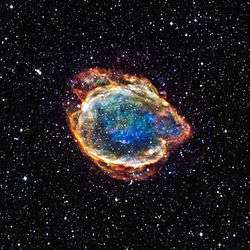Electroweak star
An electroweak star is a theoretical type of exotic star, whereby the gravitational collapse of the star is prevented by radiation pressure resulting from electroweak burning, that is, the energy released by conversion of quarks to leptons through the electroweak force. This process occurs in a volume at the star's core approximately the size of an apple, containing about two Earth masses.[1]
The stage of life of a star that produces an electroweak star is theorized to occur after a supernova collapse. Electroweak stars are denser than quark stars, and may form when quark degeneracy pressure is no longer able to withstand gravitational attraction, but may still be withstood by electroweak burning radiation pressure. This phase of a star's life may last upwards of 10 million years.[1]
See also
- Electroweak force
- Chiral anomaly
- Sphaleron
- Quark nova
- Quark star
- Lepton
- Quark
- Degenerate matter
- Degeneracy pressure
References
- 1 2 D. Shiga (4 January 2010). "Exotic stars may mimic big bang". New Scientist. Retrieved 2010-02-18.
Sources
- "Theorists Propose a New Way to Shine -- And a New Kind of Star: 'Electroweak'". ScienceDaily. 15 December 2009. Retrieved 2009-12-16.
- "A New Way To Shine, A New Kind Of Star". SpaceDaily. 16 December 2009. Retrieved 2009-12-16.
- "Theorists propose a new way to shine — and a new kind of star". Astronomy Magazine. 15 December 2009. Retrieved 2009-12-16.
- "Astronomers Predict New Class of 'Electroweak' Star". Technology Review. 10 December 2009. Retrieved 2009-12-16.
Further reading
- De-Chang Dai; Arthur Lue; Glenn Starkman; Dejan Stojkovic (2009). "Electroweak stars: how nature may capitalize on the standard model's ultimate fuel"". arXiv:0912.0520
 [hep-ph]. Bibcode: 2009arXiv0912.0520D
[hep-ph]. Bibcode: 2009arXiv0912.0520D
External links
- Tudor Vieru (15 December 2009). "New Type of Cosmic Objects: Electroweak Stars". Softpedia. Retrieved 2009-12-16.

